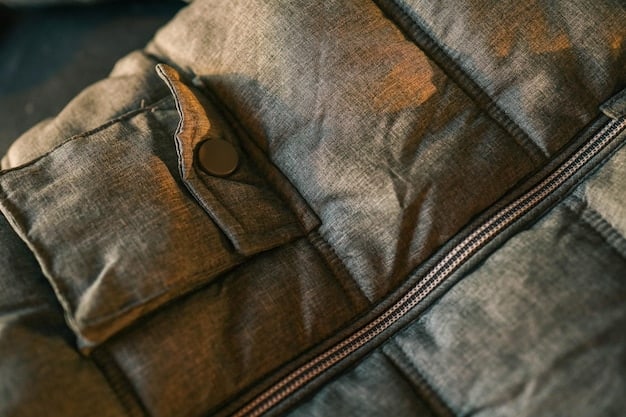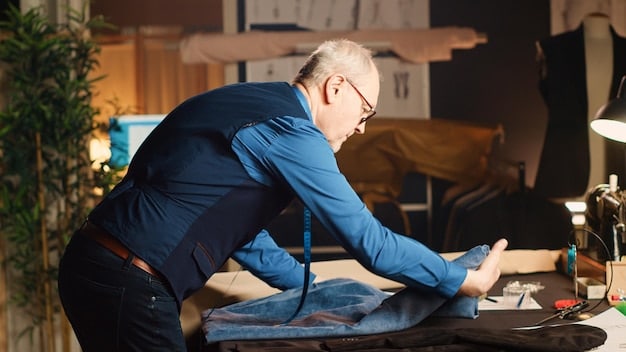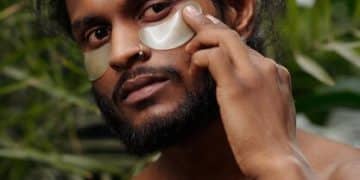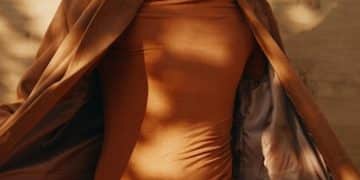The Complete Guide to Men’s Outerwear: Coats, Jackets, and More

The Complete Guide to Men’s Outerwear: Coats, Jackets, and More offers an in-depth look at essential garments for men, from classic coats to stylish jackets. Learn how to choose the right outerwear for any occasion, ensuring both style and protection from the elements.
Navigating the world of men’s outerwear can feel overwhelming. From deciphering fabric types to understanding the nuances of different styles, it’s easy to feel lost. But don’t worry, this comprehensive guide is here to help. The Complete Guide to Men’s Outerwear: Coats, Jackets, and More aims to simplify your choices and empower you to make confident decisions, ensuring you stay stylish and comfortable, whatever the weather.
Whether you’re building a versatile wardrobe or searching for that one perfect piece, understanding the options available is key. This guide will walk you through the essential types of men’s outerwear, providing insights into their unique features, perfect occasions, and styling tips. Consider this your go-to resource for all things men’s outerwear.
Understanding the Essentials of Men’s Outerwear
Men’s outerwear is more than just protection from the elements; it’s a statement of style and personality. Understanding the basics—types, fabrics, fits—is essential for making informed choices. Let’s break down the key elements that constitute a well-curated outerwear collection. This segment of The Complete Guide to Men’s Outerwear: Coats, Jackets, and More will help you get started.
Types of Coats
Coats are typically longer and heavier than jackets, designed for colder weather. They offer superior warmth and a more formal appearance.
- Overcoat: A classic choice, often made of wool or cashmere, ideal for formal occasions. Can be worn over suits or more casual attire.
- Trench Coat: Originally designed for military use, the trench coat is a timeless option for rainy weather. Features include a double-breasted closure, belt, and water-resistant fabric.
- Pea Coat: A shorter, double-breasted coat with wide lapels, often made of heavy wool. A versatile option that can be dressed up or down.
When selecting a coat, consider factors like the climate you live in and the occasions you’ll be wearing it for. A wool overcoat is great for formal events in cold weather, while a trench coat is perfect for rainy days. The pea coat is a versatile choice for everyday wear.

Types of Jackets
Jackets are generally shorter and lighter than coats, making them suitable for milder weather or layering. They come in a wide variety of styles, from casual to more refined.
- Bomber Jacket: A classic aviation-inspired jacket, typically made of leather, nylon, or cotton. Features include a ribbed collar, cuffs, and hem.
- Denim Jacket: A versatile wardrobe staple, perfect for casual wear. Can be layered over t-shirts, sweaters, or hoodies.
- Leather Jacket: A timeless option that adds a touch of edge to any outfit. Available in various styles, including biker jackets, racer jackets, and flight jackets.
Choosing the right jacket depends on the occasion and your personal style. A leather jacket adds a cool, edgy vibe to an outfit, while a denim jacket is a casual and versatile option. Bomber jackets offer a sporty and stylish look.
Understanding the different types of coats and jackets is the first step in building a well-rounded outerwear collection. Each style serves a unique purpose, and choosing the right one can elevate your look and keep you comfortable.
Selecting the Right Fabric for Your Outerwear
The fabric of your outerwear plays a significant role in its durability, warmth, and overall appearance. Different fabrics are better suited for certain climates and occasions. This part of The Complete Guide to Men’s Outerwear: Coats, Jackets, and More will help you understand the options.
Wool
Wool is a natural fiber that offers excellent warmth and insulation. It’s a popular choice for coats and jackets designed for cold weather.
Wool comes in various weights and weaves, from heavy Melton wool to lighter flannel wool. Melton wool is often used for overcoats and pea coats, while flannel wool is suitable for sport coats and lighter jackets. Wool is also water-resistant to some extent, making it a practical choice for rainy weather.
Leather
Leather is a durable and stylish material that provides protection from the elements. It’s a popular choice for jackets and vests.
- Full-Grain Leather: The highest quality leather, known for its durability and natural appearance.
- Top-Grain Leather: A slightly less expensive option, still durable but with a more uniform appearance.
- Bonded Leather: A less expensive option made from leftover leather scraps. It’s not as durable as full-grain or top-grain leather.
When choosing leather outerwear, consider the type of leather and the quality of the construction. Full-grain leather will develop a unique patina over time, adding to its character.
Synthetic Fabrics
Synthetic fabrics like polyester, nylon, and acrylic offer various benefits, including water resistance, durability, and affordability.
- Polyester: A versatile fabric that is often used in raincoats and windbreakers. It’s water-resistant and easy to care for.
- Nylon: A strong and durable fabric that is commonly used in bomber jackets and parkas. It’s also water-resistant.
- Acrylic: A synthetic fiber that resembles wool. It’s often used in sweaters and knit jackets.
Synthetic fabrics are a practical choice for outerwear that needs to withstand harsh weather conditions. They are also generally less expensive than natural fabrics like wool and leather.
Selecting the right fabric for your outerwear depends on your needs and preferences. Consider the climate you live in, the occasions you’ll be wearing it for, and your budget. With a little research, you can find the perfect fabric to keep you comfortable and stylish.
Styling Tips for Men’s Outerwear
Choosing the right outerwear is only half the battle; styling it correctly is equally important. The right outerwear can elevate your entire outfit, while the wrong choice can detract from your look. Here are some styling tips to help you make the most of your outerwear. This section of The Complete Guide to Men’s Outerwear: Coats, Jackets, and More will give you ideas on improving your look.
Layering
Layering is a key element of styling outerwear. It allows you to adapt your outfit to changing weather conditions and add visual interest to your look.
Start with a base layer like a t-shirt or dress shirt, then add a mid-layer like a sweater or cardigan. Finally, top it off with your outerwear. Experiment with different combinations to find what works best for you.
Accessorizing
Accessories can add personality and style to your outerwear. Scarves, hats, and gloves are practical and stylish options.
Choose accessories that complement your outerwear and the rest of your outfit. A wool scarf can add warmth and sophistication to an overcoat, while a beanie can add a casual touch to a bomber jacket.
Matching Occasions
Choosing the right outerwear for the occasion is essential. A formal event calls for a different style than a casual outing.
An overcoat is a classic choice for formal occasions, while a leather jacket is better suited for casual events. Consider the dress code and the setting when choosing your outerwear.
Color Coordination
Coordinating colors is essential for completing your entire look. If you aren’t sure of colors, you can never fail with black, navy, and grey.
When styling your outerwear, pay attention to color coordination. Choose colors that complement each other and create a cohesive look. Neutral colors like black, navy, and gray are versatile options that can be paired with a variety of outfits.
Styling tips can greatly improve your overall look. You can elevate your look with the right knowledge and accessories.
The Importance of Fit and Comfort
No matter how stylish your outerwear is, if it doesn’t fit properly, it won’t look its best. A well-fitted coat or jacket enhances your silhouette and provides comfort. This segment in The Complete Guide to Men’s Outerwear: Coats, Jackets, and More will discuss the importance of these factors.
Shoulder Fit
The shoulder fit is one of the most crucial aspects of outerwear. The shoulder seam should lie flat on your shoulder and follow its natural curve.
If the shoulder seam extends beyond your shoulder, the outerwear is too big. If the shoulder seam is pulled inward, the outerwear is too small. A proper shoulder fit ensures a comfortable and flattering fit.
Sleeve Length
The sleeve length should be appropriate for the style of outerwear. Generally, the sleeves should end at the wrist bone.
For coats, the sleeves should be long enough to cover your shirt cuffs. For jackets, the sleeves can be slightly shorter. The correct sleeve length ensures that your arms have freedom of movement without looking sloppy.
Body Fit
The body fit should be comfortable and allow for layering. The outerwear should not be too tight or too loose.
You should be able to button or zip up the outerwear without feeling constricted. There should be enough room to layer a sweater or shirt underneath. A proper body fit ensures that your outerwear looks tailored and comfortable.
A well-fitted coat or jacket can make a significant difference in your overall appearance. Take the time to find outerwear that fits you properly, and you’ll be sure to look your best.
Caring for Your Men’s Outerwear
Proper care can extend the life of your outerwear and keep it looking its best. Different fabrics require different cleaning methods, so it’s important to follow the care instructions on the garment label. This portion of The Complete Guide to Men’s Outerwear: Coats, Jackets, and More will provide some important insights on maintenance.
Wool Coats
Wool coats should be dry cleaned to preserve their shape and quality. Avoid washing wool coats in the washing machine, as this can cause them to shrink or lose their shape.
Between dry cleanings, you can spot clean your wool coat with a damp cloth and a mild detergent. Be sure to test the detergent on an inconspicuous area first to ensure that it doesn’t damage the fabric.
Leather Jackets
Leather jackets should be cleaned by a professional leather cleaner. Avoid washing leather jackets in the washing machine or using harsh chemicals, as this can damage the leather.
- Condition your leather jacket regularly to keep it soft and supple.
- Store your leather jacket in a cool, dry place away from direct sunlight.
Synthetic Outerwear
Synthetic outerwear like polyester and nylon can be washed in the washing machine on a gentle cycle. Use a mild detergent and avoid using bleach.
Hang your synthetic outerwear to dry or tumble dry on low heat. Avoid using high heat, as this can damage the fabric.

Taking proper care of your outerwear can keep it looking its best for years to come. Follow the care instructions on the garment label and invest in quality cleaning products. Caring for your investments will ensure they continue to keep you looking and feeling great.
Proper maintenance prolongs the life of your valuables. Ensure that you are maintaining your items according to their needs.
| Key Aspect | Brief Description |
|---|---|
| 🧥 Types of Outerwear | Coats like overcoats and jackets such as bomber jackets each serve unique purposes. |
| 🧵 Fabric Choices | Wool, leather, and synthetic materials all impact durability and warmth. |
| 👔 Styling Tips | Layering and accessorizing are key to maximizing the versatility of outerwear. |
| 📐 Importance of Fit | Proper fit is paramount for both comfort and the overall aesthetic of outerwear. |
Frequently Asked Questions
Coats are typically longer and heavier, designed for colder weather, offering superior warmth. Jackets are generally shorter and lighter, suitable for milder weather or layering.
When choosing outerwear, make sure the shoulders fit properly, the sleeves end at the wrist bone, and there is enough room for layering without feeling constricted.
Wool is great for warmth, leather for durability and style, and synthetic fabrics for water resistance and affordability. Your best choice depends on the climate and occasion.
Leather jackets should be cleaned by a professional leather cleaner. Condition it regularly to keep it soft, and store it in a cool, dry place, away from direct sunlight.
Typically, leather jackets are better suited for casual events. For formal occasions, opt for a classic overcoat. Consider the dress code when choosing attire.
Conclusion
In summary, The Complete Guide to Men’s Outerwear: Coats, Jackets, and More can help you learn about everything from fabrics to styling tips. By understanding the essentials and making informed choices, you can build a versatile outerwear collection that complements your personal style and keeps you comfortable in any weather.
Armed with this knowledge, you’re now ready to confidently navigate the world of men’s outerwear and make sartorial choices that reflect your unique taste and lifestyle.





